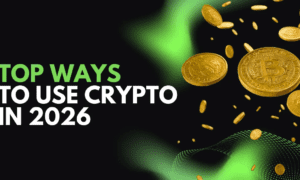According to recent data, the number of cryptocurrency users worldwide is growing. In some countries, people already use cryptocurrency to purchase luxury goods, airline tickets, and clothes.
- How do payment service providers (PSPs) process cryptocurrency payments compared to card payments?
- Which pros and cons do cryptocurrency payments have compared to card payments?
Maria Berdysheva, Head of Systems Analytics at Paysend, a fintech expert and a leader in the digital technology field with a focus on digital payments, addresses both questions in this article.
1. Digital Payments Landscape
If we take the number of payment card transactions over the years and calculate the Compound Annual Growth Rate (CAGR), it becomes clear that the growth of payment card transactions in Europe has slowed from 2017 to the present, compared to earlier years. Why is this happening? First, more people prefer mobile wallets. Second, more people choose to pay with cryptocurrency. Let’s compare cryptocurrency payment processing to card payment processing.
2. Card Payment Processing
2.1. Payment Process From a User’s Perspective
Imagine a user places an order in an online marketplace and selects a card as the payment method. In this case, the payment process from the user’s perspective looks like this (below is an example of a positive scenario):
- The user enters their card details and submits the payment.
- (Optionally) The user is redirected to their bank’s page for 3DS authentication.
- After successful 3DS authentication, the user is redirected to the online marketplace’s page, displaying payment status.
2.2. Payment Service Providers
From a technical perspective, for an online marketplace to accept payments, it integrates with a PSP (e.g., Stripe). Generally, a PSP offers a simple interface (e.g., API) to make it easy and fast for merchants to enable payments on their websites or mobile applications. There are many PSPs. Some of the most well-known are Stripe and PayPal. All of them compete with each other. Typically, the primary competitive advantage is lower processing fees. However, a simple integration method is also crucial. When it’s simple, merchants can connect to the service faster. For example, when a merchant integrates with Stripe, Stripe manages the entire payment process, keeping all complexities at their own (PSP’s) layer.
2.3. Payment Process From a Payment Service Provider’s Perspective
Next, we will delve into how payment processing works on the PSP’s side. Here, I’ll continue to use Stripe as a reference.
At the moment, when the user places an order, the merchant sends an API request to create a payment session and receives a response. The response includes a URL. The merchant’s website redirects the user to Stripe’s URL. There, the user enters their card details and submits the payment. The PSP performs the following:
2.3.1. 3DS Authentication
In the EU, cardholder authentication is mandatory. If the card is issued by a European bank when the user enters their card details and submits the payment, the PSP first attempts to perform 3DS authentication before processing the payment. The purpose of authentication is to ensure that the user attempting to make the payment is the cardholder.
To perform 3DS authentication, the PSP integrates with the 3DS server. The PSP sends an authentication request (AReq) and receives a response (ARes). The authentication request includes the card details, cardholder details, device details, and merchant details.
Who decides on cardholder authentication? The issuing bank is responsible for this process.
Upon receiving an authentication request, the issuing bank decides whether the user needs to go through a challenge. If required, the authentication response (ARes) includes an ACS URL. ACS URL is a URL of the issuing bank’s website, where the user may be asked, for example, to enter a code.
Once the user completes the authentication, the PSP receives the authentication result (Cardholder Authentication Verification Value (CAVV)).
2.3.2. Payment Authorization
When the CAVV is received, the PSP requests payment authorization. It requires communication with the payment network (Visa, Mastercard, UnionPay, etc.). The payment network routes the request to the issuing bank. The issuing bank verifies the CAVV and reserves the funds from the user’s card’s balance. Then, the issuing bank returns the payment authorization result.
The PSP receives the authorization result. It displays a payment result for the user and redirects them to the merchant’s website, where they can see the updated order status.
At the end of the business day (or at scheduled settlement times), the payment network performs the settlement, and the merchant receives funds to their acquiring bank account.
2.4. Problems
As you can see, card payment processing requires many intermediaries: the PSP, 3DS server, payment network, issuing bank, acquiring bank, etc. Each of the intermediaries takes their fees, which makes the processing more expensive. Moreover, despite all efforts, card payment processing is still not perfectly secure for users and merchants (e.g., friendly fraud).
Next, we will analyze cryptocurrency payment processing.
3. Cryptocurrency payments processing
3.1. Payment Process From a User’s Perspective
Do you remember our user selected a card as the payment method in an online marketplace? Now, imagine they select cryptocurrency as the payment method. In this case, the payment process from the user’s perspective looks like this (below is an example of a positive scenario):
- The user selects a cryptocurrency and network.
- The user scans the QR code that encodes the blockchain address with their wallet (e.g., BitPay, Trust Wallet, MetaMask, or others).
- Once the payment is sent, the online marketplace gets a notification. If the received payment ≥ the requested amount, the user is redirected to the online marketplace’s page, displaying the payment status.
3.2. Payment Process From a Payment Service Provider’s Perspective
Similarly to card payment processing, for an online marketplace to accept cryptocurrency payments, it integrates with a PSP (e.g., Triple-A).
For many reasons, even the biggest PSPs, like Stripe, struggle to enter many territories with crypto payment processing services. As a result, merchants often need separate PSPs to accept card and cryptocurrency payments.
The cryptocurrency payment process starts similarly to card payments. The merchant sends an API request and receives the URL in the response. The merchant’s website redirects the user to the service provider’s URL. There, the user selects cryptocurrency and network. The PSP performs the following:
3.2.1. Generating a New Address
The most straightforward way for a merchant to accept a cryptocurrency payment is to ask a user to send funds to a blockchain address. An address is a hash string encoding a destination for receiving funds in a blockchain. The format of addresses differs for different blockchains. For example, Bitcoin uses the Bech32 address format, while Solana uses the Base58 address format. The PSP generates a unique address for each merchant’s payment request. The address is usually displayed as a QR code for users’ comfort.
3.2.2. Monitoring Blockchain
When the user sends funds to the given address, then the transaction appears in the blockchain.
PSPs actively monitor blockchain to detect and retrieve incoming transactions. By monitoring the blockchain, they can identify when funds are sent to specific addresses associated with their merchant clients.
The PSP processes the transaction and stores it in a database. Here, it is necessary to mention the blockchain confirmations. Each transaction in the blockchain must have a certain number of confirmations sufficient to be considered as confirmed in the blockchain. Waiting for confirmations can take a while. That is the main challenge for all PSPs. They are trying to balance the sufficient number of confirmations and the waiting time. If you reduce the number of confirmations, it brings risks like double-spend attacks. If not, users have to wait a long time until their payment is confirmed. Once a transaction is confirmed, it is immediately reflected on the merchant’s balance. Generally, that’s all of the processing.
3.4. Problems
There are many problems with cryptocurrency. For PSPs, the most significant one is the regulation. While regulations are more or less straightforward in some countries, in others, there are a lot of unclear requirements that are challenging to meet.
Another challenge is cybersecurity. Cryptocurrency PSPs are prime targets for hacking attempts, phishing, and social engineering attacks. This is also a risk for merchants because if the PSP is hacked, funds will be stolen from all the wallets, including merchants’ wallets.
4. Conclusion
So, summing up the results of the comparison, there are several points where cryptocurrency payments have a strong advantage:
- Lower fees. Blockchain technology reduces the need for intermediaries in payment processing, which lowers costs.
- When the user pays with cryptocurrency, the payment process is much easier than with a bank card.
However, card payments still dominate, mainly due to the imperfect regulation of crypto assets.
Why not choose both (cards and crypto)?
Unfortunately, PSPs usually specialize either in card payment processing or in cryptocurrency payment processing. As a result, merchants must integrate with separate providers to accept both payment methods, which can be easier said than done sometimes. However, if you, as a merchant, are up for this, offering both payment methods could be a winning strategy.



































